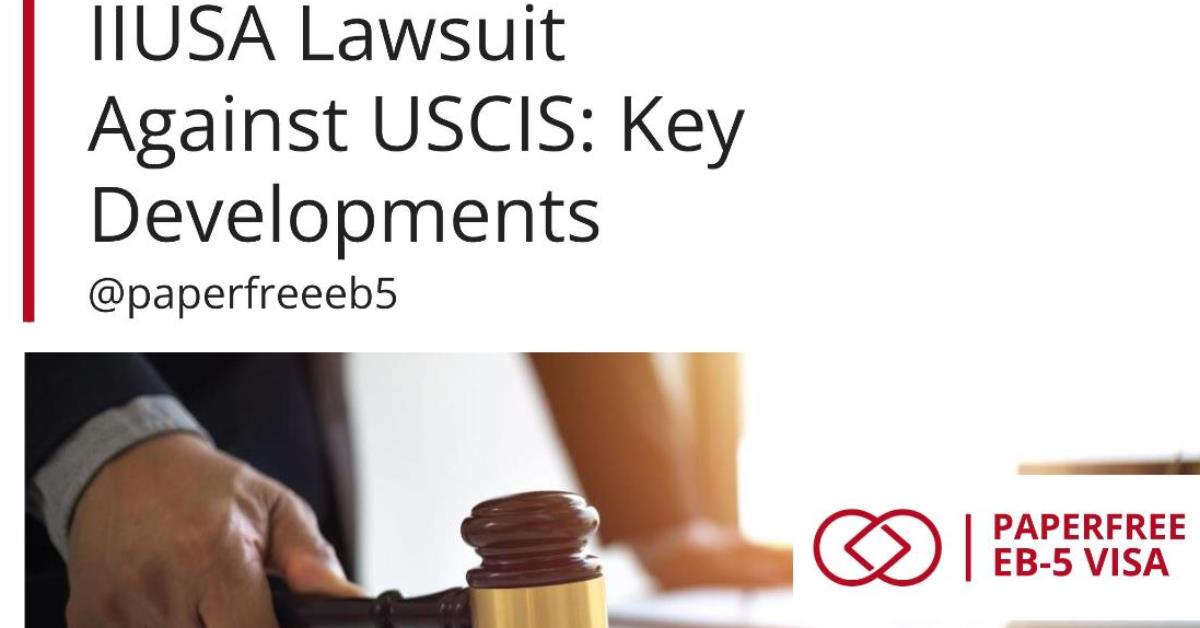| | by Sidra Jabeen | Content Manager, Paperfree Magazine |
Legal Tug-of-War: The IIUSA Challenge Against USCIS's EB-5 Policy Changes
Explore the latest developments in IIUSA's lawsuit against USCIS over the EB-5 sustainment period policy change and its impact on foreign investorslast updated Friday, May 16, 2025
#eb-5 program #eb-5 investors
AD
Get Access to EB 5 Visa Investment Projects
Key Insights
- IIUSA Lawsuit Filed (March 2024): IIUSA filed a lawsuit against USCIS, arguing the new EB-5 sustainment period violated the Administrative Procedures Act by bypassing the public comment process.
- Court Hearing and Skepticism (January 28, 2025): The court expressed skepticism about the legality of the new policy, raising questions about whether USCIS adhered to proper rule-making procedures.
- Settlement Deadline (February 2025): The court directed USCIS to explore settlement with IIUSA within 30 days, with the possibility of a ruling if no agreement is reached by the end of the month.
- Reversion to Original Sustainment Period (If IIUSA Wins): If IIUSA prevails, the sustainment period could revert to the original, longer timeframe tied to conditional residency, which would extend the time investors must keep their capital at risk.
- Impact on Visa Retrogression: Investors from China and India involved in urban TEA projects post-March 2022 may face delays in capital return due to visa retrogression if the lawsuit succeeds.
- Impact on Developers: Developers may face challenges with capital management and project timelines if the sustainment period is extended to the original or a longer period.
- Transparency and Precedent: The lawsuit highlights administrative transparency issues and could set a precedent for how future regulatory changes are handled by USCIS and other federal agencies.
IIUSA Lawsuit Against USCIS: Latest Developments and Implications for the EB-5 Program
In a significant legal development that could reshape the future of the EB-5 Immigrant Investor Program, Invest in the USA (IIUSA), a prominent industry advocacy group, has filed a lawsuit against the U.S. Citizenship and Immigration Services (USCIS) over a controversial policy change related to the program's "sustainment period." This lawsuit, filed in March 2024, challenges a revision to the EB-5 program’s sustainment period, a crucial aspect for investors seeking to obtain U.S. residency through capital investment.
Recent Legal Developments: Court Expresses Skepticism and Settlement Discussions
The lawsuit has gained momentum in early 2025, with major developments occurring in January. During a crucial hearing on January 28, 2025, the court expressed skepticism about the legality of USCIS's modified sustainment period policy. The court raised questions about whether the policy change adhered to proper legal procedures and whether USCIS had bypassed essential rule-making processes. This skepticism signals a potential victory for IIUSA, especially since the court directed USCIS to explore the possibility of settling with IIUSA within 30 days.
If a settlement is not reached by the court-imposed deadline, the case could proceed to a ruling that might restore the previous sustainment period guidelines, which many believe would provide a more stable environment for investors.
The Disputed Policy Change: Reducing the Sustainment Period
At the heart of the lawsuit is a change made by USCIS in October 2023 to the EB-5 program’s sustainment period policy. Historically, EB-5 investors were required to keep their investment "at risk" for a period that generally lasted for the entire two years of their conditional residency. However, USCIS’s new policy modified this requirement by reducing the sustainment period to two years starting from the time the funds are initially invested—rather than from the moment the investor receives their conditional Green Card.
The change, though offering investors the potential for quicker capital recovery, has sparked considerable controversy. Critics argue that the modification undermines the long-term stability of the program and could destabilize investment expectations, especially for large-scale development projects reliant on long-term funding.
IIUSA’s Legal Challenge: Lack of Public Input
IIUSA argues that USCIS’s modification to the sustainment period policy violated the Administrative Procedure Act (APA) by bypassing the public comment process. Under the APA, federal agencies must allow stakeholders—including investors, developers, and industry experts—to provide input on significant policy changes before they are finalized.
According to IIUSA, the failure to engage in this transparent and consultative process undermines the legitimacy of the EB-5 program and may have misled investors about the terms and timelines of their investments. As such, IIUSA is seeking a judicial ruling to restore the original sustainment period, one that begins with the investor’s conditional residency and extends through the two-year period.
Why the Sustainment Period Matters
The sustainment period is a key element of the EB-5 program. It ensures that investors maintain their capital at risk in a job-creating project, thus contributing to the U.S. economy over an extended period. The original policy required that investors maintain their capital throughout the entirety of their conditional residency. The new two-year period starting from the investment date, however, means that investors could recover their capital sooner, potentially altering the financial and operational planning of both investors and developers.
For many EB-5 investors, especially those involved in urban Targeted Employment Area (TEA) projects, the ability to reclaim their capital earlier could offer immediate financial relief. However, this has raised concerns within the development community, as it may alter the financial structure of projects that rely on EB-5 funds for longer-term planning. Developers could face difficulties if they must find alternative funding sources or adjust project timelines to accommodate the revised sustainment period.
Potential Impacts on Foreign Investors
If IIUSA’s lawsuit is successful, it could have significant implications for foreign investors—particularly those from countries with high demand for EB-5 visas, such as China and India. Investors in these countries often face visa retrogression, a process where the number of available visas for certain nationalities becomes backlogged, delaying the visa issuance process.
In this context, a ruling in favor of IIUSA could exacerbate delays for these investors, especially if the sustainment period were to revert to the longer original guidelines. Retrogression could force these investors to keep their capital invested in U.S. projects for a longer period than initially anticipated, making the capital recovery process even more complex and uncertain.
Additionally, investors involved in TEA projects might find themselves facing extended timelines for capital returns, particularly if the project relies on a longer sustainment period. The uncertainty surrounding these potential delays could influence future investment strategies and impact the attractiveness of the EB-5 program for investors seeking quicker returns on their capital.
The Legal Landscape: Broader Implications for USCIS and Administrative Law
Beyond the immediate impact on the EB-5 program, the IIUSA lawsuit raises important questions about the transparency of administrative procedures. The case underscores the need for federal agencies, such as USCIS, to adhere to established rule-making protocols when making significant changes to immigration policies. The APA mandates that agencies engage in transparent and consultative processes when altering policies that have wide-reaching implications for stakeholders.
If the court rules in favor of IIUSA, it could set a precedent for future administrative actions, not only within immigration law but also in broader contexts of U.S. administrative governance. A ruling that upholds IIUSA’s position would likely reaffirm the necessity of public participation and scrutiny in the regulatory process, ensuring that future changes to immigration policies are subject to greater scrutiny and public participation.
Potential Outcomes and Their Consequences
The ongoing lawsuit between Invest in the USA (IIUSA) and the U.S. Citizenship and Immigration Services (USCIS) over the EB-5 program's sustainment period could lead to several significant outcomes, each carrying distinct implications for investors, developers, and the broader U.S. immigration system.
1. Reversion to the Original Sustainment Period
If IIUSA Prevails:
- Policy Reversion
The court may mandate USCIS to revert to the original sustainment period, which begins once the investor obtains their conditional Green Card. This would restore the previous requirement for investors to maintain their capital at risk throughout the conditional residency period. - Impact on Investors
Investors would be required to keep their capital invested for a longer duration, potentially extending the timeline for capital recovery. This change could affect investment strategies and financial planning, especially for those who anticipated a shorter investment horizon. - Impact on Developers
Developers might face challenges in managing capital flow, as the extended sustainment period could influence project financing and timelines. The need to accommodate longer capital retention could affect project planning and investor relations.
2. Adoption of a Five-Year Sustainment Period
If IIUSA's Proposal is Accepted:
- Policy Change
The court could direct USCIS to implement a five-year sustainment period, starting from the time the investor's funds are fully deployed into the job-creating enterprise. This aligns with IIUSA's petition for rulemaking. - Impact on Investors
A five-year commitment would provide a more stable investment horizon, potentially enhancing the predictability of capital returns. However, it would also extend the period before investors can access their capital, which could affect liquidity and financial planning - Impact on Developers
Developers might benefit from a more predictable capital base, allowing for long-term project planning and stability. The extended sustainment period could also attract investors seeking longer-term commitments, potentially increasing the pool of available capital for large-scale projects.
3. Upheld Two-Year Sustainment Period
If USCIS's Position is Upheld:
- Policy Continuation
The current two-year sustainment period would remain in effect, starting from the time the investor's funds are deployed into the job-creating enterprise. - Impact on Investors
Investors could benefit from a shorter commitment period, allowing for quicker capital recovery. This could enhance liquidity and provide more flexibility in financial planning. - Impact on Developers
While the shorter sustainment period might attract investors seeking quicker returns, it could also lead to increased capital redeployment, potentially complicating project financing and planning. Developers might need to manage more frequent capital inflows and outflows, which could affect project timelines and financial stability.
4. Prolonged Legal Uncertainty
If the Lawsuit Results in Prolonged Uncertainty:
- Policy Ambiguity
A prolonged legal battle could result in continued ambiguity regarding the sustainment period, leaving stakeholders uncertain about investment timelines and regulatory expectations. - Impact on Investors
Uncertainty could lead to hesitation in making investment decisions, as investors may be wary of potential policy changes that could affect their capital commitments and returns. - Impact on Developers
Developers might face challenges in securing funding and planning projects without clear regulatory guidelines. The lack of clarity could deter potential investors and complicate project financing.
5. Potential for Regulatory Reform
If the Court Directs USCIS to Engage in Rulemaking:
- Policy Development
The court could instruct USCIS to engage in a formal rulemaking process to establish a clear and standardized sustainment period policy. - Impact on Investors
A transparent rulemaking process could lead to a more predictable and stable investment environment, allowing investors to make informed decisions based on established guidelines. - Impact on Developers
Clear regulations would enable developers to plan projects with greater certainty, aligning capital requirements with defined policy timelines. This could facilitate more efficient project execution and financial management.
Book Your Free Consultation with Paperfree EB-5 Visa Experts. Get Personalized Advice and Investment Plans. Book Your Free Consultation Today!

Conclusion
The outcome of the IIUSA lawsuit against USCIS holds significant implications for the EB-5 program. A decision favoring IIUSA could lead to a longer sustainment period, affecting capital recovery timelines for investors and potentially altering project financing strategies for developers. Conversely, upholding the current two-year period could offer shorter investment horizons but may introduce challenges related to capital redeployment and project planning. The industry awaits the court's decision, which will shape the future dynamics of EB-5 investments and the broader U.S. immigration landscape.
Disclaimer:
The information provided in this post is for general informational purposes only and should not be construed as legal advice. The details about the IIUSA lawsuit, USCIS policy changes, and their implications are based on the latest available information as of February 2025. Legal outcomes may vary depending on individual circumstances, and any action taken based on this content is at the reader's own risk. For personalized legal advice or updates on this matter, it is recommended to consult with a qualified immigration attorney or legal expert.

Pages Related to #eb-5 program
- EB 5 investment projects list USA

- EB5 Investment Projects | Here's All You Need To Know

- EB5 Investment Visa Guide 2025

- Best EB5 Regional Center List | American EB5 Regional Center

- Paperfree Investment Visa EB-5 Program is Your Your Clear Path to Green Card USA

- EB 5 Visa Requirements 2024, A Guide To on eligibility for U.S. Investment-Based Residency

- EB5 Processing Time: A Journey Towards Green Card 2026 | Paperfree.com

- July 2025 Visa Bulletin: EB-5 Investment Visa Program Shows Positive Movement

Popular Page
Benefits of the EB-5 Visa Program| A Comprehensive Guide
Book a Free Complimentary Call
Search within Paperfree.com
real estate investing Investment Visa USA Investment Magazine Private Real Estate Funds real estate funds
